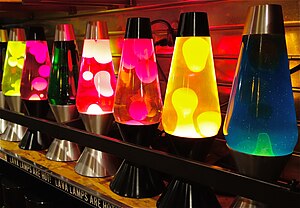

A lava lamp is a decorative lamp, invented in 1963 by British entrepreneur Edward Craven Walker, the founder of the lighting company Mathmos.
It consists of a bolus of a special coloured wax mixture inside a glass vessel, the remainder of which contains clear or translucent liquid. The vessel is placed on a base containing an incandescent light bulb whose heat causes temporary reductions in the wax's density and the liquid's surface tension. As the warmed wax rises through the liquid, it cools, loses its buoyancy, and falls back to the bottom of the vessel in a cycle that is visually suggestive of pāhoehoe lava, hence the name. The lamps are designed in a variety of styles and colours.
Lava lamps can be associated with hippie and cannabis cultures.[1][2]
- ^ McCleary, John Bassett (2004). Hippie Dictionary: A Cultural Encyclopedia of the 1960s and 1970s (Revised and Expanded ed.). Ten Speed Press. p. 299. ISBN 978-1580085472.
The oil, heated by electricity, produces bubbles that slowly ascend through the colored liquid, creating a hypnotic display which is amusing to folks high on mind-expanding drugs.
- ^ Halperin, Shirley; Bloom, Steve (2008). Pot Culture: The A-Z Guide to Stoner Language and Life. Abrams Image. ISBN 978-0810994409.
Hippie accessory invented by Edward Craven Walker in England in 1963, [...] Stoners stare at these blobs for hours at a time, a practice known as 'spacing out.'